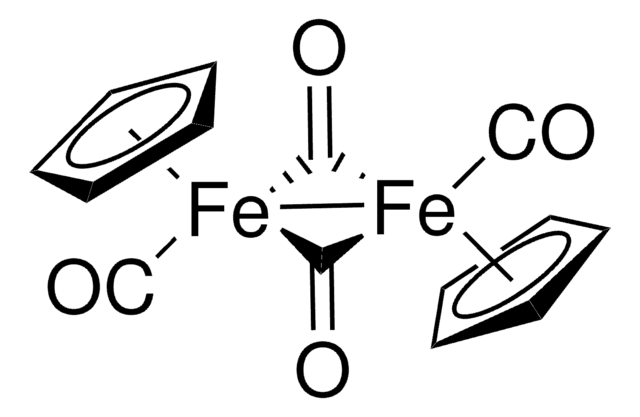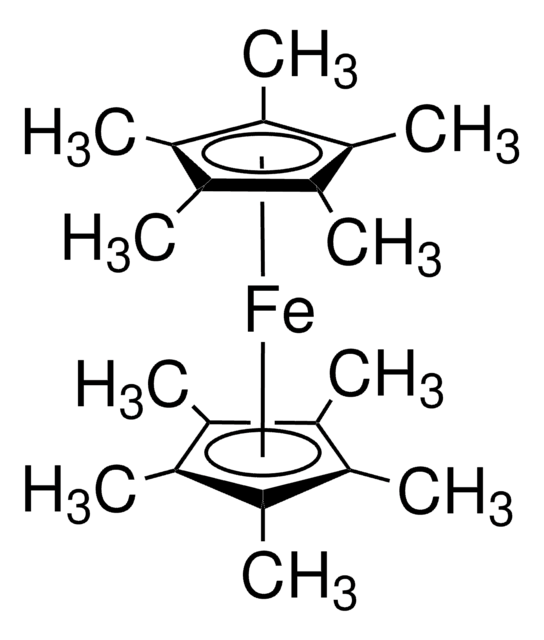481718
Iron(0) pentacarbonyl
>99.99% trace metals basis
Sinonimo/i:
Iron(0) carbonyl, Pentacarbonyliron(0)
About This Item
Prodotti consigliati
Densità del vapore
6.74 (vs air)
Tensione di vapore
35 mmHg ( 25 °C)
40 mmHg ( 30.3 °C)
Saggio
>99.99% trace metals basis
Forma fisica
liquid
Temp. autoaccensione
122 °F
Impiego in reazioni chimiche
core: iron
reagent type: catalyst
Caratteristiche più verdi
Catalysis
Learn more about the Principles of Green Chemistry.
sustainability
Greener Alternative Product
Indice di rifrazione
n20/D 1.5196 (lit.)
P. eboll.
103 °C (lit.)
Punto di fusione
−20 °C (lit.)
Densità
1.49 g/mL at 25 °C (lit.)
Categoria alternativa più verde
, Aligned
Temperatura di conservazione
2-8°C
Stringa SMILE
[Fe].[C-]#[O+].[C-]#[O+].[C-]#[O+].[C-]#[O+].[C-]#[O+]
InChI
1S/5CO.Fe/c5*1-2;
FYOFOKCECDGJBF-UHFFFAOYSA-N
Cerchi prodotti simili? Visita Guida al confronto tra prodotti
Descrizione generale
Applicazioni
- To fabricate Fe-based anode materials for high-performance aqueous secondary Ni−Fe batteries. It helps to achieve good safety, high power density, long term-life cycle, and high energy density.
- As a precursor to synthesize highly stable, colloidal magnetic iron nanoparticles with narrow size distribution. These nanoparticles are potential candidates for MRI contrasting agents and magnetically separable catalysts.
- To synthesize zero valent sustainable iron nanocatalysts for reduction reactions.
- Addition reactions
- Decomposition via photolysis
- Preparation of magnetic Fe onion-like fullerene micrometer-sized particles of narrow size distribution via thermal decomposition
- Preparation of a heptanuclear iron carbonyl cluster used in catalytic hydrosilane reduction of carboxamides
- Precursor for preparation of Fe nanoparticles for photocatalytic hydrogen evolution under highly basic conditions
Avvertenze
Danger
Indicazioni di pericolo
Consigli di prudenza
Classi di pericolo
Acute Tox. 1 Inhalation - Acute Tox. 2 Oral - Acute Tox. 3 Dermal - Flam. Liq. 2
Codice della classe di stoccaggio
3 - Flammable liquids
Classe di pericolosità dell'acqua (WGK)
WGK 1
Punto d’infiammabilità (°F)
5.0 °F - closed cup
Punto d’infiammabilità (°C)
-15 °C - closed cup
Dispositivi di protezione individuale
Eyeshields, Faceshields, Gloves, type ABEK (EN14387) respirator filter
Certificati d'analisi (COA)
Cerca il Certificati d'analisi (COA) digitando il numero di lotto/batch corrispondente. I numeri di lotto o di batch sono stampati sull'etichetta dei prodotti dopo la parola ‘Lotto’ o ‘Batch’.
Possiedi già questo prodotto?
I documenti relativi ai prodotti acquistati recentemente sono disponibili nell’Archivio dei documenti.
I clienti hanno visto anche
Articoli
Solvothermal synthesis of nanoparticles: applications from nanocircuits and nano-optical circuits to nanomagnetics and biotech.
Magnetic nanoparticles have attracted tremendous attention due to their novel properties and their potential applications in magnetic recording, magnetic energy storage and biomedicine.
Spintronics offer breakthroughs over conventional memory/logic devices with lower power, leakage, saturation, and complexity.
The properties of many devices are limited by the intrinsic properties of the materials that compose them.
Il team dei nostri ricercatori vanta grande esperienza in tutte le aree della ricerca quali Life Science, scienza dei materiali, sintesi chimica, cromatografia, discipline analitiche, ecc..
Contatta l'Assistenza Tecnica.












